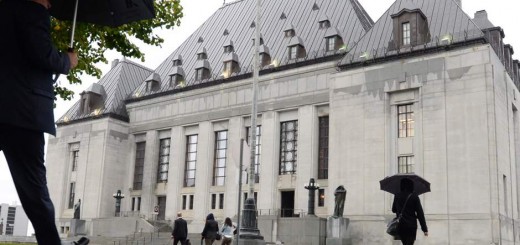Barendregt v Grebliunas Hearing: Admitting New Evidence in Family Law Cases

New evidence is rarely introduced or accepted at appeal courts. However, this rule of thumb could change as the Supreme Court of Canada (“SCC”) hears submissions from counsel in Barendregt v Grebliunas. It is one of three cases the SCC is hearing on child custody matters Dec. 1st and 2nd, 2021, but this one could have reverberating impacts on family law jurisprudence generally.
The parties, Ashley Suzanne Barendregt (“Barendregt”) and Geoff Bradley Grebliunas (“Grebulinas”), appeared before the British Columbia Supreme Court (“BCSC”) to finalize their divorce and determine the primary residence of their two children (Barendregt v Grebliunas, 2019 BCSC 2192, para 1 [Barendregt I]). While the trial court ruled in favour of Barendregt, the British Columbia Court of Appeal (“BCCA”) allowed Grebliunas’s appeal after he introduced new evidence to substantiate an earlier claim he made at trial (Barendregt v Grebliunas, 2021 BCCA 11, para 26 [Barendregt II]). The issue before the SCC is to determine the appropriate test for admissibility of evidence in family law cases and decide whether the new evidence could be introduced in this context.
The Facts
The parties married in March 2013 and purchased their family home in West Kelowna in June that same year (Barendregt I, para 5). At the time of purchase, the home was under foreclosure and was not in good condition, but the parties planned to fix-up the place while they lived there (Barendregt I, para 6). The parties made a living with Grebliunas as a trained carpenter and Barendregt taking on various janitorial jobs, but they were not financially well off. The parties eventually had two children together and managed childcare by working opposite shifts (Barendregt I, para 9).
On November 14, 2018, the parties had an argument which resulted in both parties alleging they were assaulted by the other (Barendregt I, para 11). While Grebliunas was at work later that evening, Barendregt took their two boys and drove to her parents’ place in Telkwa, 1,000 km away from Kelowna. Barendregt then commenced the divorce action on November 26, 2018. While both parties were deemed to be good parents, Grebliunas was described as being overbearing while Barendregt was painted as having a violent temper (Barendregt I, para 18-9).
Barendregt wanted to live with her children and parents in Telkwa, but Grebliunas wanted Barendregt to return to Kelowna so they could share childcare duties together(Barendregt I, paras 16-7). As Barendregt wished to settle down in Telkwa, she requested that her address be recorded as the children’s primary residence. That said, her children were already in kindergarten and pre-school in Kelowna and living with Grebliunas’s mother as the trial proceeded. Grebliunas stated that he would remain in his unfinished home and work on outstanding renovations, which included all of the house except for his children’s room (Barendregt I, para 32).
Trial Court Reasoning
The trial judge began his analysis at s. 16(9) of the Divorce Act RSC 1985 (2nd Supp.), c.3 which provided that in making custody orders, the court must “not take into consideration the past conduct of any person unless the conduct is relevant to the ability of that person to act as a parent of a child” (Barendregt I, para 27). The trial judge also added that he should consider which of the alternative parenting arrangements would best promote the children’s interests (Barendregt I, paras 28).
From the facts, the trial judge identified two issues that impacted his analysis of the children’s best interests: the financial situation of the parents and the relationship between the parties (Barendregt I, para 31). At the date of the trial, Grebliunas had a $260,100 mortgage on the Kelowna home—with half the interest belonging to Barendregt—and a $73,500 line of credit to make renovations on the unfinished home, amounting to a total of $333,600 in bank loans (Barendregt I, para 31). Grebliunas testified that he would need an additional $70,000 to pay contractors to finish the home renovations (Barendregt I, para 32). Thus, the court deemed that Grebliunas would not be in a sound financial position even if the house was successfully renovated and sold. However, Grebliunas responded that he could be financially stable with the assistance of his father, who had the capacity to refinance the home, pay off outstanding loans, and provide renovation costs (Barendregt I, paras 37-8). The trial judge was unconvinced by this plan, stating that the uncertainty in Grebliunas’s plan could mean that Grebliunas—and as a result, his children—would not be able to stay in Kelowna (Barendregt I, para 40).
As to the second issue—which the court deemed as more significant than the first—the trial judge held that due to Grebliunas’s allegedly assaulting Barendregt and his continued animosity towards her, the relationship between the parties would remain strained. The judge reasoned that the parties’ strained relationship would in turn make co-parenting difficult (Barendregt I, para 41). Further, the trial judge reasoned that Barendregt would require “emotional supports” following the divorce, which would only be available in Telkwa with her parents (Barendregt I, para 46). The trial judge concluded that for these reasons, it would be in the best interest of the children to designate the primary residence as Barendregt’s Telkwa home and that she was able to relocate there with her children (Barendregt I, para 49).
Appellate Court Reasoning
Grebliunas appealed the trial decision and introduced new evidence before the BCCA. The new evidence played a pivotal role and resulted in the BCCA reassessing the trial judge’s reasoning. The evidence included supporting documents that showed that Grebliunas had sold Barendregt half of the interest in the family property; Grebulinas refinanced the home so that his parents owned was a joint tenant and owend one-half of the interest; and that the home renovations were underway, paid for by his parents (Barendregt II, para 27). Basically, the new evidence demonstrated that Grebliunas had done everything he had promised to do when he was before the trial court.
The court first identified the legal framework involved in assessing the admissibility of new evidence. To provide a definition, new evidence is evidence that arises as a result of events that happen after the trial, while fresh evidence is evidence available at the time of the trial but not introduced (Barendregt II, para 29). The court confirmed that while the test on the admissibility of fresh evidence was established in Palmer v The Queen [1980] 1 SCR 759 [Palmer], there was no clear test on the admissibility of new evidence (Barendregt II, para 30). Nevertheless, the court identified that new evidence could be admitted in “rare” or “exceptional” circumstances (Barendregt II, para 31). One such circumstance is when assumptions made by the trial judge about future events are confirmed or rebutted with the introduction of the new evidence (Barendregt II, paras 32,34). In other words, new evidence can be admitted if it establishes “that a premise or underpinning or understanding of the trial judge that was significant or fundamental or pivotal has been undermined or altered”(Barendregt II, para 43).
The court identified two circumstances in case law where new evidence could be introduced: when there had been material alterations in the parties’ financial position, and in family cases (Barendregt II, paras 45, 47). The current case satisfied both circumstances and deemed that the evidence could be admitted.
The court then proceeded to reevaluate the best interests of the children in light of the new evidence. They stated that the trial judge’s concerns about financing the family home had been resolved, making it more certain that Grebliunas could provide the children with financial stability (Barendregt II, para 65). As for the second issue on the strained relationship of the parties, the BCCA found that the trial judge erred in making determinations on issues that had not been raised by Barendregt’s counsel. For example, Barendregt’s counsel did not make the argument that Grebliunas’ hostility forced Barendregt to move to Telkwa nor did they argue that Barendregt was significantly impelled to move to Telkwa with her children, yet the trial judge made determinations on these matters anyways (Barendregt II, paras 70-1). Moreover, the BCCA asserted that the trial judge’s reasoning that Barendregt would need to relocate for emotional support was largely unfounded in case law (Barendregt II, para 74). When these errors were viewed together, the court concluded that “the best interests of the children would be served with their primary residence being in Kelowna and with their being parented by both their parents” (Barendregt II, para 90).
Speculating on the SCC Decision
The SCC has already informed the parties about the issue it will be handling: the appropriateness of the Palmer framework to inform the admissibility of new evidence. This is in light of the fact that the BCCA had dismissed Barendregt’s objections to admitting evidence when she had relied on the Palmer factors to discredit Grebliunas’ evidence (Barendregt II, para 52). To recap, fresh evidence can be admitted if it satisfies the four Palmer factors: the evidence could not be adduced at trial (due diligence requirement); the evidence is relevant (relevancy requirement); the evidence is credible (credibility requirement); and the evidence can affect the result (cogency requirement) (Palmer, p 775; see a summary of the factors in Nicholas Hay’s post, The Shafia Case and Unwelcome Changes to The Palmer Test).
The BCCA had relied partially on the Palmer test in admitting new evidence, as it assessed the due diligence, relevancy, and cogency of the evidence (Barendregt II, paras 52 and 62). However, the court stated that due diligence was not necessarily required in assessing new evidence. Rather, they added a contextual analysis of the case, in effect formulating a stricter Palmer test.
Upon reviewing the facta of the parties and intervenors of the case, it is evident that parties disagree on the application and scope of the Palmer test. Barendregt, who is appealing the decision, is requesting that the Palmer test be applied, albeit with stricter limits, while counsel for Grebliunas requests a more flexible approach (Appellant’s Factum, para 62; Respondent’s Factum, para 54). The intervenors—the Office of the Children’s Lawyer (OCL) and the West Coast LEAF Association—suggest that the Palmer test should be relaxed where cases concern children’s best interests or family violence issues (LEAF Factum, para 26; OCL Factum, para 15). What is clear is that the SCC will be unlikely to stray from the existing Palmer factors and that if they decide to modify the test, it would likely be more inclusive of contextual factors. Thus, the Palmer test may become a two-part exercise, where courts would first assess the circumstance where new evidence is introduced, then apply the factors. Whether it would be relaxed or restricted remains unclear.
From a policy standpoint, applying a relaxed Palmer test in child custody or family violence cases may motivate parties to try to improve their circumstances between trial and appeal decisions such that the appellate court views the appealing party more favourably, as Grebliunas had in the present case. Ultimately, this could result in children having improved relationships with both parents. That said, giving parties a “second chance” to prove their desirability as a parent may increase the burden on the already backlogged judicial system and draw out the legal dispute, potentially making the children feel more uncertain about their home and increasing animosity between the parties.
Conclusion
As this case is one of three child custody cases being heard by the SCC Dec. 1st and 2nd, 2021, it is likely that the three decisions would collectively impact the way courts view the ‘best interest of the child’. However, Barendregt v Grebliunas could have implications even broader than just in the realm of family law and expand the jurisprudence concerning evidence law, making this case one that would be interesting to watch.








Join the conversation